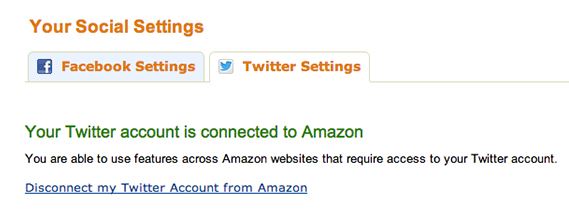Brand Disruptors: Amazon Changes the Game, Turns Twitter Into a Shopping Mall
Introducing #AmazonCart. Add it now. Buy it later. https://t.co/FmfLNqRqs6
— Amazon (@amazon) May 5, 2014
Tweeting just got sweeter—or shopping just got Tweeter—for Amazon customers thanks to a new social integration that lets users add items to their shopping cart by responding to links on Twitter with the hashtag #AmazonCart (in the U.S) or #AmazonBasket (in the U.K.), a move that makes social shopping easier and—dare we say—fun.
“Add it now, buy it later” is the slogan, and it seems to be as simple to use as that tagline. Once an Amazon account is linked to a Twitter account, responding to a link with the requisite hashtag puts the item in your cart along with a reply tweet from @MyAmazon.
While hashtags make the process simple, it’s simultaneously a public broadcast of what one is buying—as well as user-generated marketing for Amazon and the latest step in making shopping more social and seamless.

“The feature not only extends the retail reach of Amazon beyond its own website, reducing purchase friction," TechCrunch comments, "but co-opts Twitter users into product marketing activity—since they are publishing tweets indicating which items they are buying from Amazon.”
This latest partnership between the world’s largest e-tailer and the microblogging platform brings commerce and social together in one shopping cart, a digital feat of untapped proportion. While American Express tested social shopping with Twitter, that partnership didn't have the scale of an e-commerce behemoth like Amazon behind it. The partnership also comes as the AmazonFresh same-day grocery service faces fresh competition from Google with the roll-out of its beta same-day delivery service in New York and Los Angeles.

Amazon has already greased the skids on "purchase friction" with its 1-click buying, but this new partnership with Twitter (and Facebook may not be far behind, as Amazon is already encouraging linking Facebook profiles in its social settings) is further future-proofing for the brand as social networks increasingly become commerce outlets in their own right, such as Instagram or Pinterest. "If the AmazonCart feature takes off, it effectively [turns] Twitter into a windowshopping platform for Amazon," adds TC.
For Twitter, it also extends the current, inadequate revenue stream of sponsored tweets. “There’s a public nature to social media, particularly with Twitter—which doesn’t have the barriers of other social media tools,” commented Julie Law, an Amazon rep, the Wall Street Journal. “We have a significant number of customers who use Twitter, and a significant number of affiliates who use Twitter, too… So to be able to allow customers to add something to their Amazon cart without leaving Twitter was sort of a logical step.”
Amazon makes it clear that product tweets only add items to your cart and purchases must still be confirmed on Amazon for check-out and payment. One area off-limits in the partnership is Lightning Deals, Amazon's limited-time daily discount promotions.
Given Amazon’s massive scale and Twitter’s 255 million active users, predictions of the latter’s demise (see The Atlantic's 1800-word eulogy for Twitter) may be decidedly premature. In another bid to innovate and monetize, Twitter CEO Dick Costolo also suggested in a CNBC interview that embedded tweets in articles could come with their own advertisements like pre-roll ads before embedded YouTube videos.
[message_box title=”As Bloomberg points out, however, this is old news in China, where two years ago:” color=”red”]Sina Weibo, China's largest microblogging site, gave users the ability to browse nearby goods and purchase them from within its mobile apps. Sina teamed up with Alibaba Group to integrate products sold by merchants on Taobao Marketplace, the country's largest e-commerce website. After Alibaba's $586 million investment in Sina's Weibo in 2013, they've added a "Buy" button underneath links to Taobao products on Weibo. The microblogging site also allows users to plug in their Alipay accounts to check out using the same payments service they use on Alibaba. The move into e-commerce has been a lucrative one for Sina's Weibo, which went public last month. Alibaba accounted for 43 percent of Weibo ad revenue over the holidays, according to a report by Bloomberg Industries.[/message_box]
Costolo & Co. must be salivating at the prospect of getting a revenue split on such shopping action—but will Twitter and Amazon users take to social shopping as eagerly as China's shoppers appear to have done?
[divider scroll_text=”Back To Top”]
